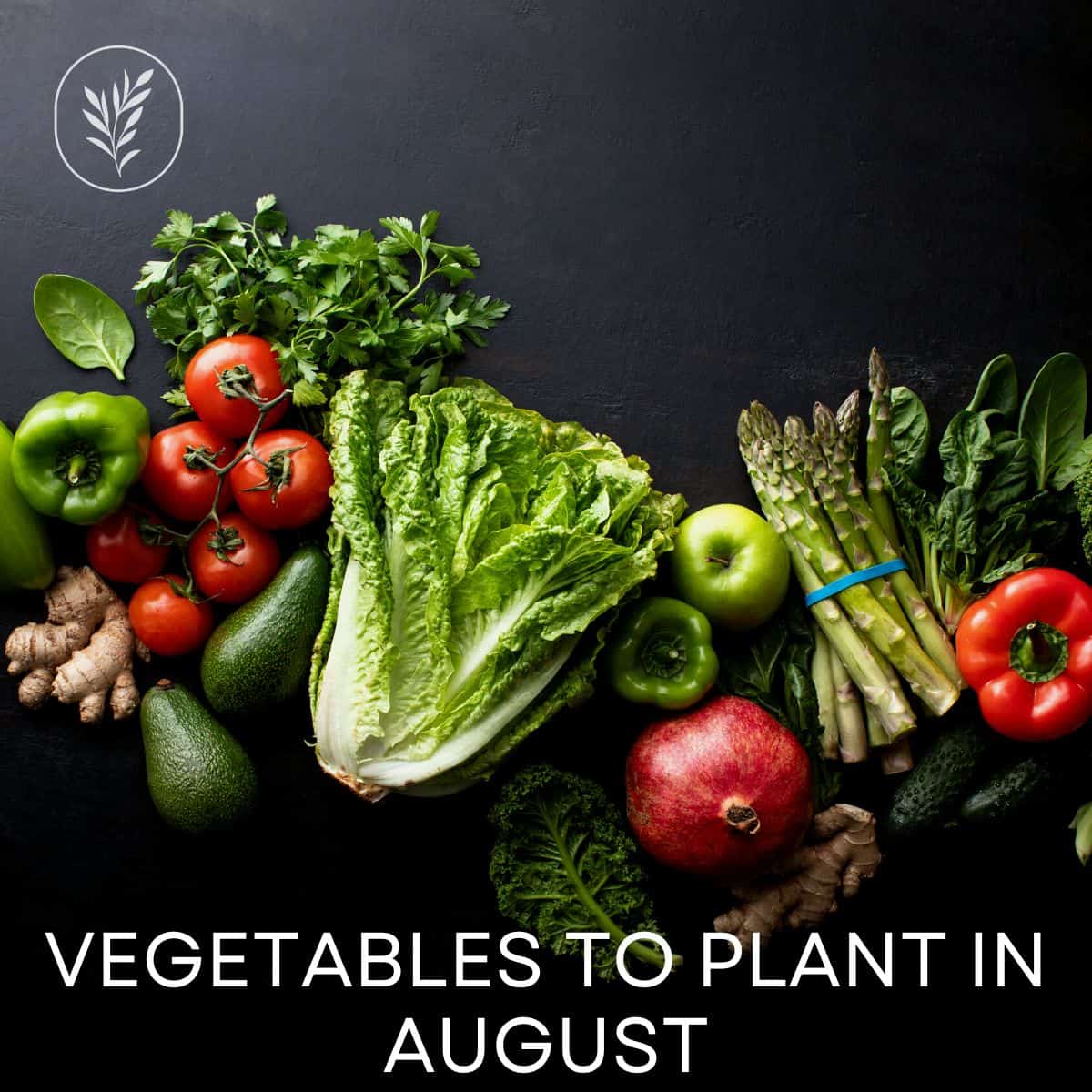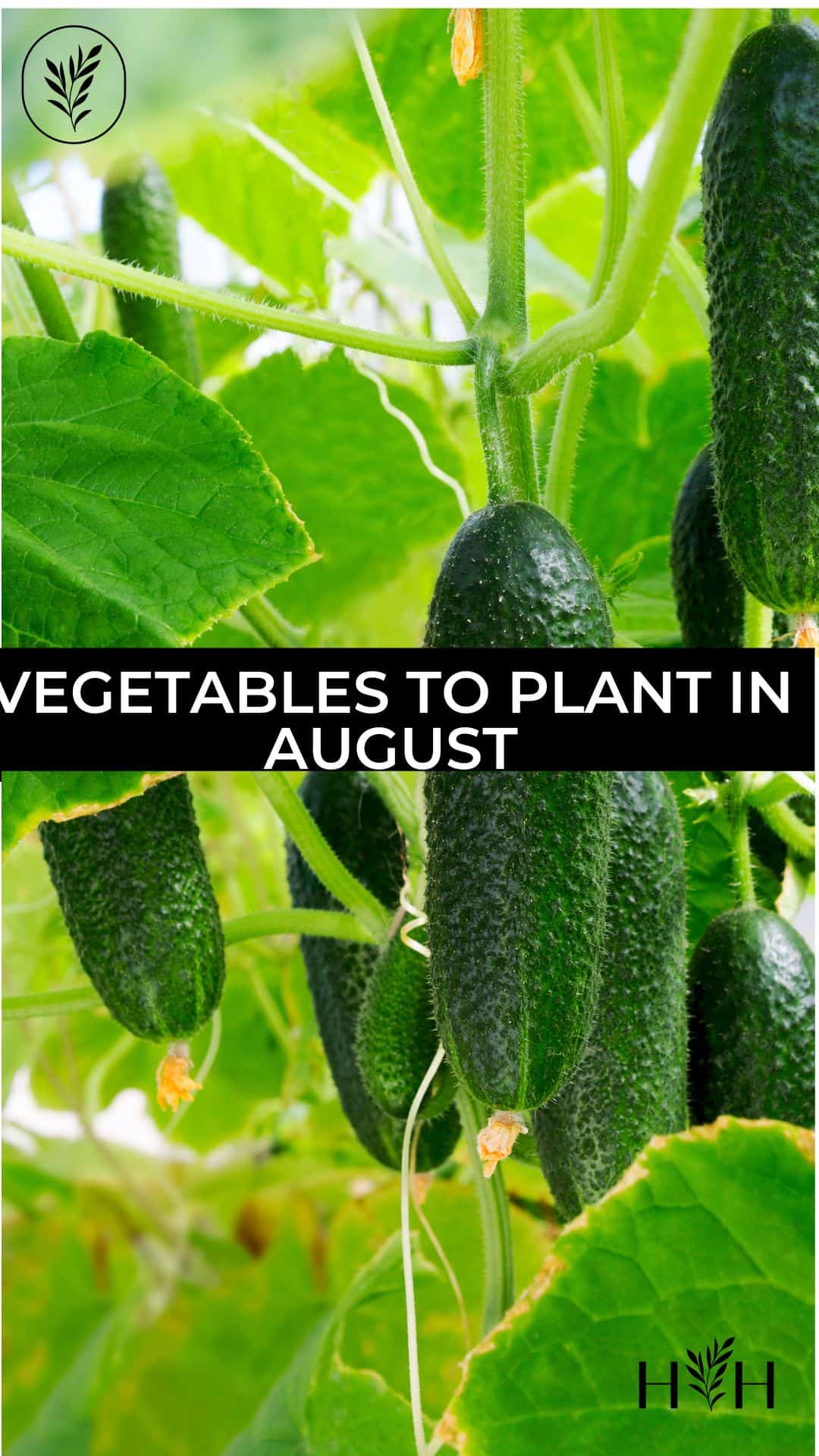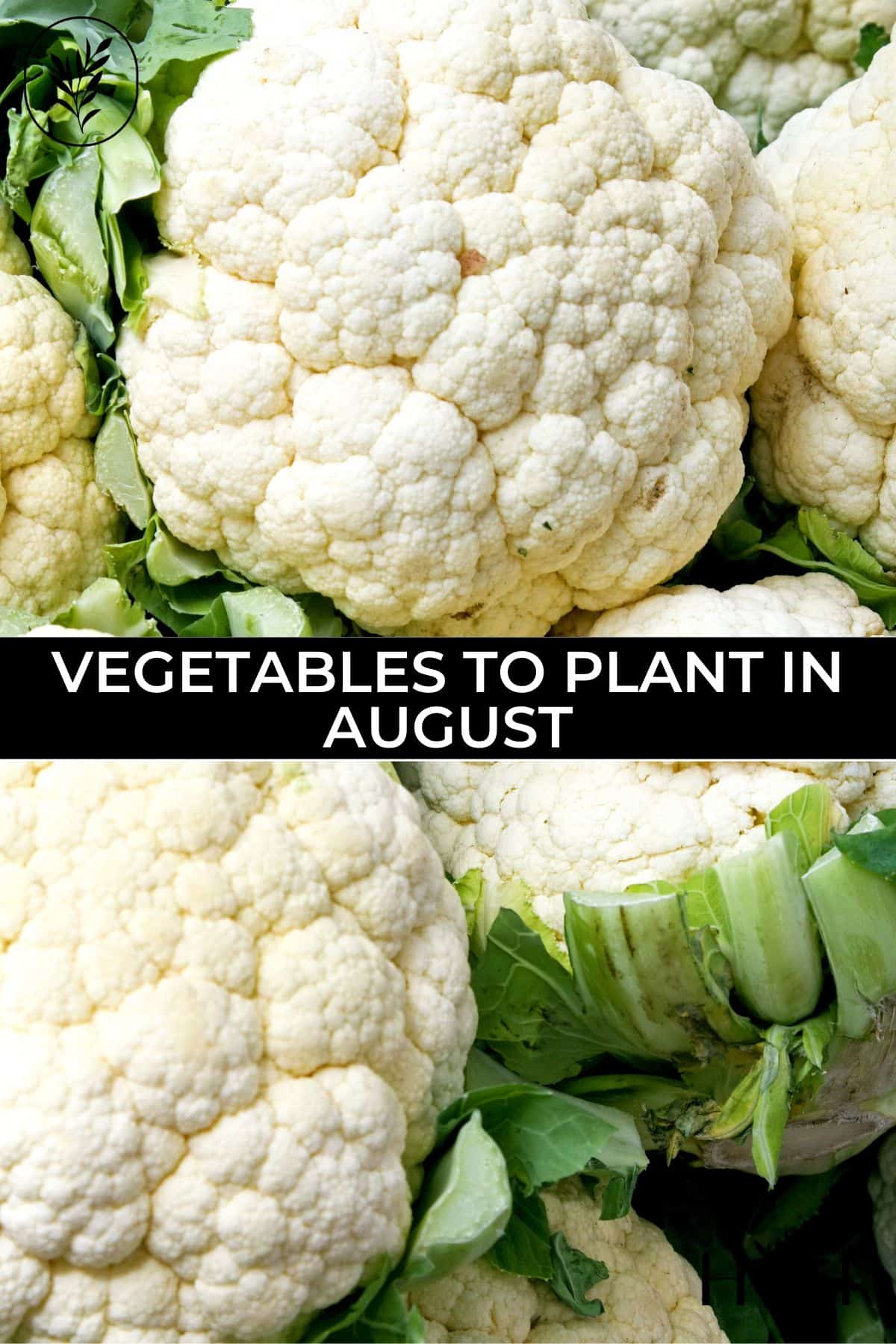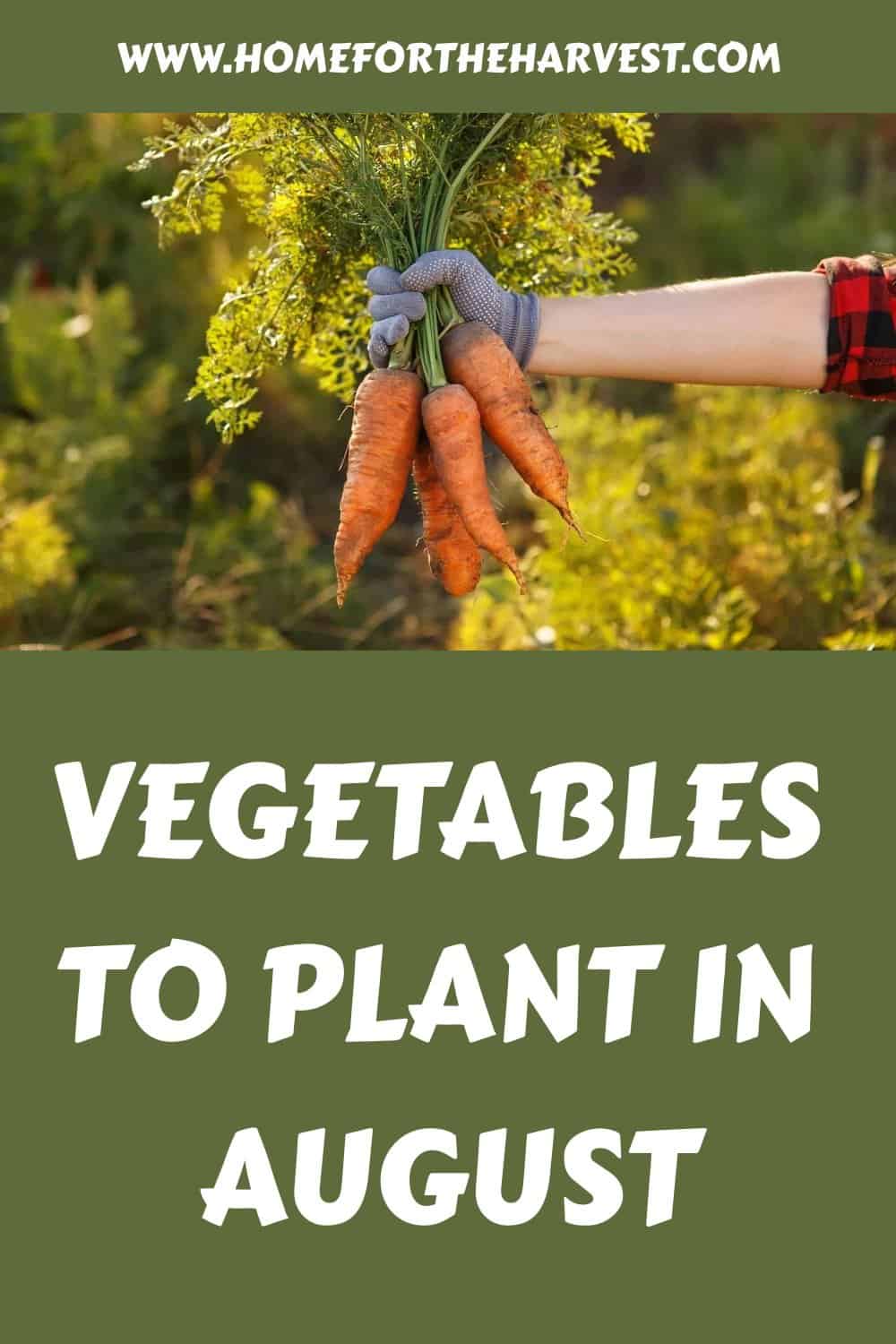The best vegetables to plant in August are generally cool-season veggies with short time-to-harvest periods. Common crops planted in the vegetable garden during the month of August include carrots, spinach, peas, broccoli, radish, and overwintering cover crops. Plants get a head start with the warm soil, air temperatures, and long days of sunlight before taking off in growth during the cooler autumn months.
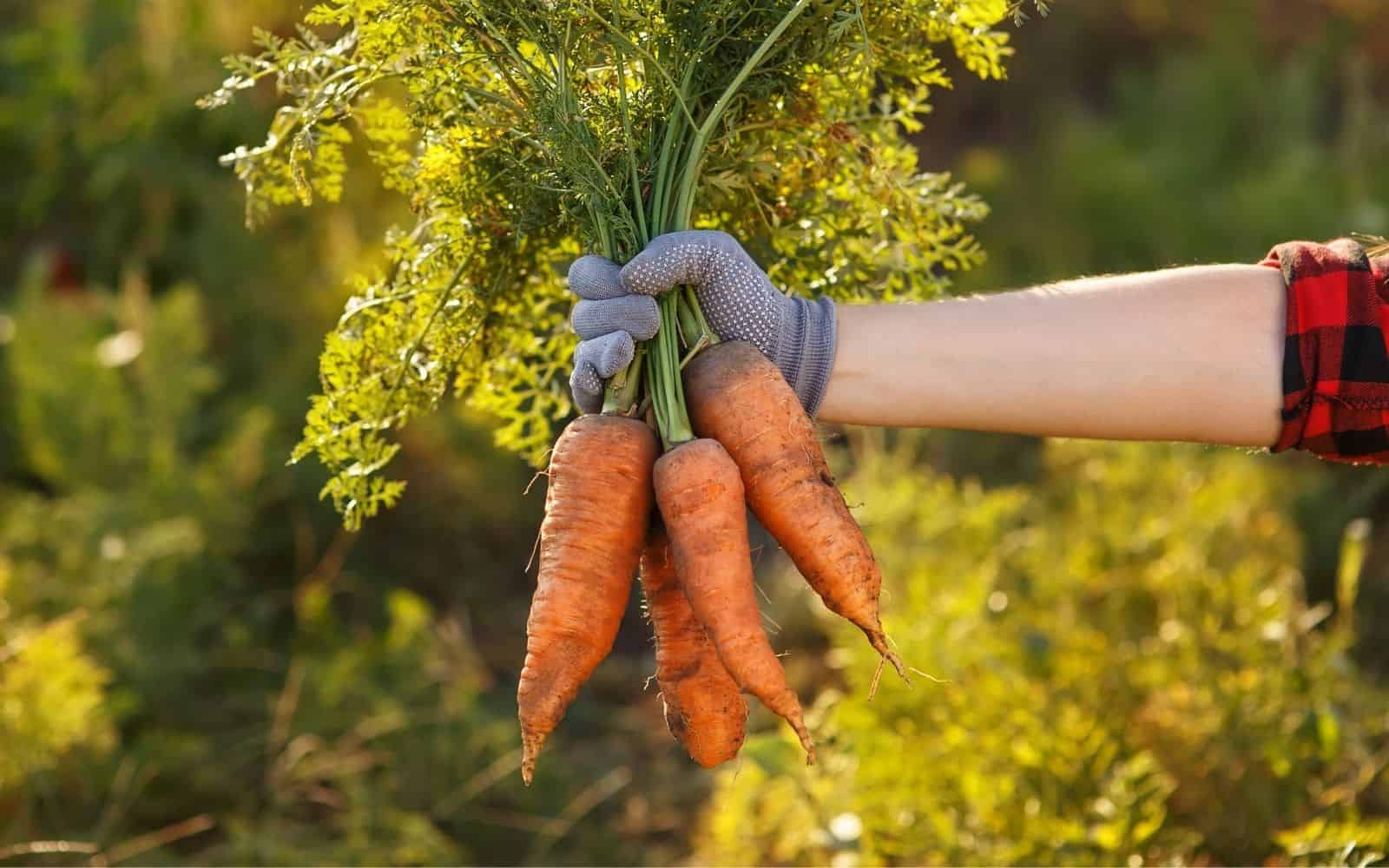
1. Carrots
Carrots can be planted in mid-summer, typically until mid-August in most temperate climates. Carrots planted in the vegetable garden in early August are often some of the sweetest, especially if they ripen in the cooler days of autumn.
Hercules Carrot is great variety for August planting. This orange Chantenay-type carrot has a very sweet flavor, growing to 7″ long in only 65 days. Hercules carrots planted in mid-August will be ready to harvest in mid-October.
While carrot seed germinates somewhat unpredictably in general, germination is possible at a wide range of temperatures, between a chilly 40°F (4°C) and a downright hot 95°F (35°C). This adaptability makes them well-suited to mid-summer planting.
Ensure the soil is kept moist until seedlings are visible to encourage germination of the tiny carrot seeds. Keep the bed weed-free if possible, and water deeply on a consistent basis. A top-dressing of organic fertilizer or homemade compost can help the carrots thrive.
Thinned carrots can be harvested and enjoyed in early fall. Later crops can be grown to full size before harvesting. Any carrots left in the ground after the first hard frost can continue to be harvested into late fall. If temperatures indicate the ground will freeze soon, cover the patch with clean straw to insulate the ground (prevent freezing) to allow for ongoing harvest into early winter.
2. Spinach
Spinach is truly a cold-weather vegetable – so much so that its very difficult to harvest in the heat of summer! Summer spinach tends to go to seed quickly, making the leftover leaves small and bitter. That said, once the real heat of summer has passed, Spinach can thrive in the autumn garden.
Sun Angel Spinach is a good variety to plant in August. Sun Angel plants are heat-resistant and produce lovely dark green leaves. This variety is a “cut-and-come-again” type of spinach that can be harvested multiple times if leaves are carefully snipped off (leaving the roots intact).
Plant spinach in mid-to-late August, preferably when soil temperatures are below 75°F (24°C). Keep the soil moist and cover with mulch to keep soil temperatures (and moisture) consistent to encourage germination. Spinach can continue to be seeded in the soil almost until the ground freezes!
Spinach plants grow best when they have ample access to water and to nutrient-rich soil. These nitrogen-loving plants can be fed when the seedlings have several sets of true leaves. Use a high-quality water-soluble organic plant food like Miracle-Gro’s Performance Organics to deliver nutrients to the seedlings.
3. Beans
Beans can be planted in early August for a mid-autumn harvest. Both pole beans and bush beans are warm-weather crops that grow well in the warm mid-summer soil. That said, bush-type snap beans tend to ripen the quickest, making them the best choice for August planting in temperate climates.
Provider Bush Bean is a good variety to plant in August. These plants are tolerant to temperatures swings, and produce wonderful 5″-long green beans. Provider Bush Beans planted in mid-August will mature in early October.
Bean plants thrive in hot weather (and warm soil), and are often less affected by pests when planted later in the growing season. Plant bush beans up to 2 months before the average first fall frost date in your local area. Bean plants cannot tolerate frost, so are often not planted in August in regions with particularly early frosts.
Beans need soil temperatures greater than 60°F (15°C) to germinate. Like other August-planted veggies, keep the newly-planted beans moist in the soil until they germinate and sprout. After the beans sprout, the soil can be allowed to dry out slightly between waterings. Maturing bean plants may not bloom or produce beans at sustained air temperatures over 90°F (32°C), but should bloom and set pods once temperatures start to drop.
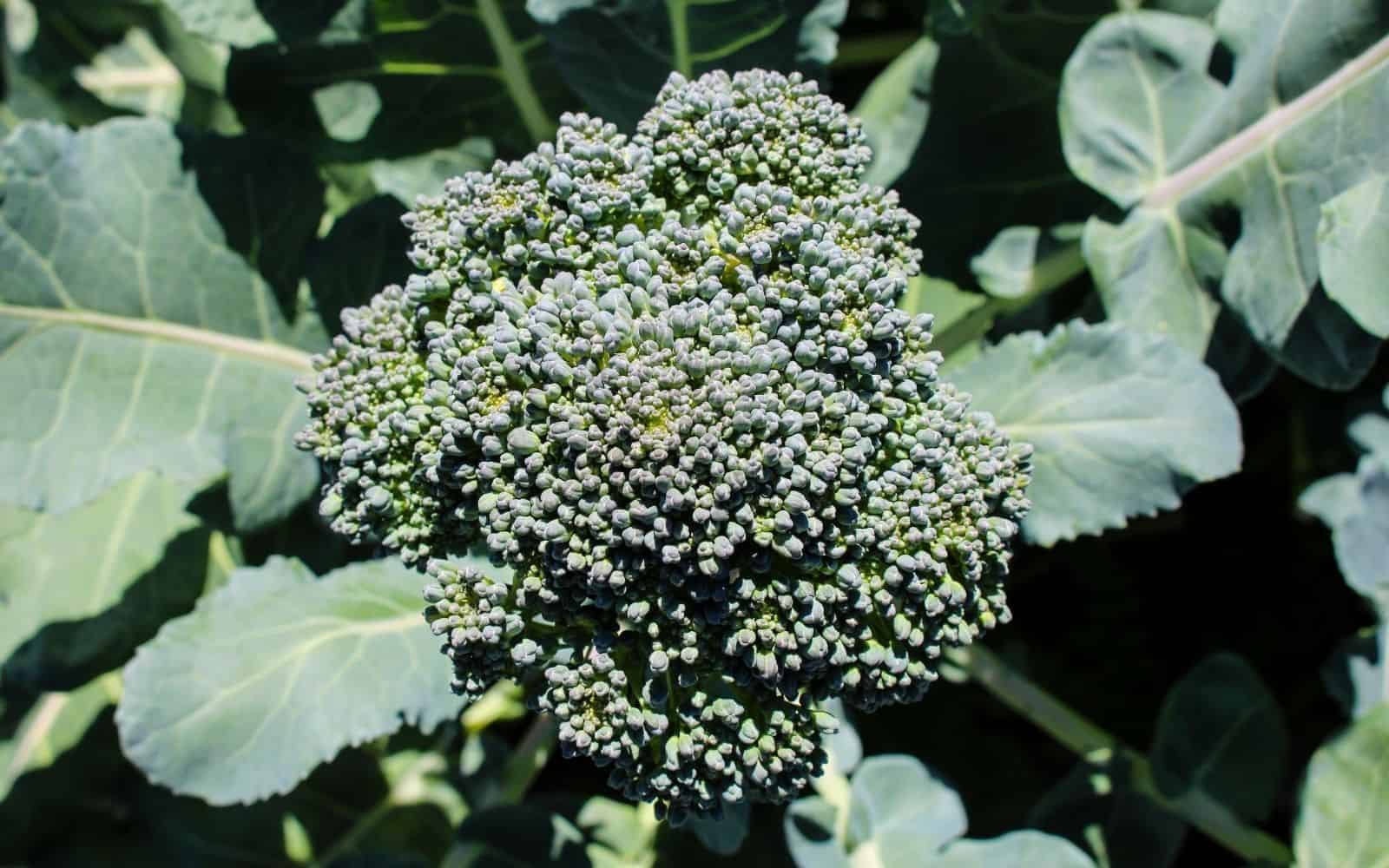
4. Broccoli
Broccoli is another cold-loving vegetable that can be planted in August. Sometimes transplants are available from the garden center in August, but often broccoli is simply direct-seeded out in the garden.
Green Magic Broccoli is a great variety for August planting. This type of broccoli is heat-tolerant, and can be grown earlier in fall than most varieties. This speedy broccoli only takes 55 days to maturity, meaning a mid-August planting would be ready in early October.
Most types of broccoli (like the wonderful Imperial Broccoli) take more like 70 days to mature. In general, plant broccoli seeds out in the garden 10 to 12 weeks before the average first fall frost date in your local area. For an area with a first fall frost date around Halloween (October 31), that would mean most types of broccoli are planted in mid-August.
Broccoli plants grow best when soil is kept moist (but not soggy) until the seedlings are well established. Mulch can help keep the moisture from evaporating in the August heat, and will also keep weeds down and stabilize soil temperatures. These plants also like feeding with homemade compost or high-quality organic fertilizer.
5. Lettuce
Lettuce is a staple cool-season crop that can be seeded throughout the month of August for fall harvests. It’s also quite easy to grow from seed (and the seed packet can be saved and seeded during many points throughout the year). Leaf lettuce types that are “cut-and-come-again” are preferable as they can be harvested multiple times.
Baby Leaf Lettuce Mix is a great choice for August-planted lettuce. This quick-grow variety has a maturity date of only 30 days, meaning a mid-August planting is ready for first harvest in mid-September.
Most gardeners can plant lettuce seeds any time in August to enjoy a fall harvest. Some gardeners choose to dedicate an entire raised garden bed to leaf lettuce, seeding every two weeks to ensure new plants are always growing to take over from the plants that have been harvested a few times already.
Lettuce seeds are another type of small seed that tends to germinate somewhat erratically (especially if temperatures are hot). Be patient if weather is hot, and keep the soil nicely moist until the seedlings are established. Organic mulch helps keep the soil moist and moderates the temperature. If using an organic fertilizer, take care to apply it to the soil directly (not to the leaves).
6. Cucumbers
Cucumbers are a quick-growing crop that can be seeded in early August for an autumn harvest. These heat-loving plants do not tolerate frost, and are typically only sown for a fall harvest in warmer climates.
Green Dragon Burpless Cucumber is a good variety for August planting. This type is an early producer and is also more cold-hardy than most cucumber plants. The flavor is sweet and the cucumbers have a maturity duration of only 50 days. Green Dragon Cucumbers planted in early August will start to mature in late September.
Cucumbers grow best when supported on trellis structures. The vines are not great climbers on their own, and are generally tied to the trellis with fabric scraps or tomato ties. Cucumber plants also need lots of moisture to thrive. Water them consistently and mulch the soil around the plant to keep water from evaporating as much as possible.
7. Cabbage
Cabbage is a cold-hardy vegetable that is often planted in August. There is quite a bit of variability in time-to-harvest between varieties, so a bit of garden planning can really help with summer-planted cabbage crops. In general, cabbage plants prefer cool weather and are generally planted in late summer when the most intense heat of summer has passed.
Stonehead Cabbage is good choice for August planting. This easy-to-grow hybrid has a short 70-day maturity period in the garden. It also has a long harvesting window in the garden (good holding ability). Stonehead Cabbages are about 4-6 pounds each, and are great for all types of culinary applications.
Cabbage is generally planted out into the garden with transplants, but can also be direct seeded into garden soil. Transplants are sometimes available in garden centers in August, but be sure to look for culinary cabbage as ornamental cabbage varieties are common in fall planters and outdoor decor.
Cabbage plants are heavy feeders and do well in a garden bed enriched with homemade compost. They can also be fed with a high-quality organic fertilizer throughout the growing season.
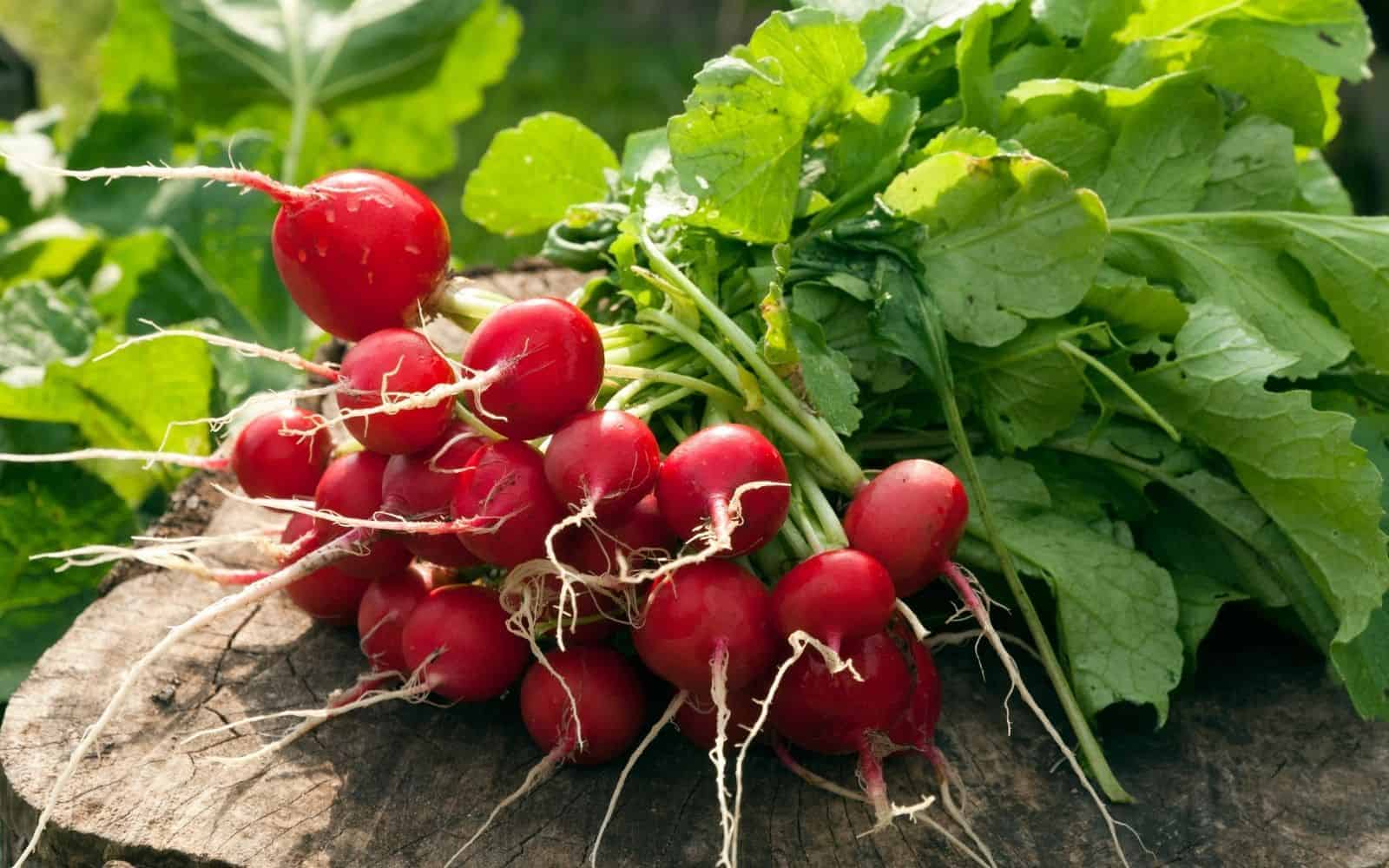
8. Radish
Radishes are a wonderful veggie crop to plant in the garden all throughout the growing season. They are generally the fastest-maturing crop in the garden, even maturing faster than lettuce!
Cherry Belle Radish is a great choice for planting in August. This open-pollinated variety is very early-maturing, taking only 20 days to maturity. These radishes are also quite small and tend to have a nice tender texture that’s not at all woody.
Radishes can generally be planted at any point in August, but do tend to grow best once the most intense summer heat has passed. These roots grow best when direct-seeded into loose soil where they have room to grow.
Radishes grow so fast that the plants are not often fertilized. Instead, prepare the garden area by working in some homemade compost prior to planting. You can also apply a very thin layer of organic mulch to the soil surface.
9. Kale
Kale is an overwintering crop that often grows very well when planted in August. This cold-hardy crop is seeded in the late summer/early fall and will continue to produce leaves through fall and into the winter. Kale planted in August is among the sweetest kale of the year, as the leaves mature in favorable cooler fall weather.
Lacinato Kale is a nice type of kale to plant in August. This heirloom variety is well-known as as year-round producer, with plants reaching maturity after 65 days. Kale planted in mid-August will be ready for first harvest in mid-October.
Kale can be either direct-seeded out in the garden or transplanted with baby seedlings. The soil should be kept moist and mulched to keep cool in the last few weeks of summertime. Mulch also keeps weeds down and minimizes soil splashing onto leaves during early fall rains.
Let the seedling plant grow for 6-8 weeks before harvesting any leaves. Harvest the first leaves from the bottom of the plant, moving up the stalk throughout the fall. Always leave a few leaves at the top so the plant can photosynthesize to make energy.
10. Cauliflower
Cauliflower is a hardy vegetable that is generally seeded in early spring and early fall. While cauliflower can seem tricky to grow, it is worth a try during your August planting (especially if you haven’t grown it before).
Snow Bowl Cauliflower is a good variety to plant in August for a fall/winter harvest. The plants are smaller than many other cauliflower varieties, with tender heads weighing around 1.5 pounds. This variety has a particularly short time-to-maturity of 55 days. Transplants that go into the garden in mid-August should be ready to harvest in early-mid October.
Cauliflower can be direct seeded during the fall planting, but is most commonly grown from transplanted seedlings. Choose a type of seedling with a date to maturity that’s before the expected first fall frost date in your area. While cauliflower plants are tolerant of frost, the white curd we eat can be damaged by frost. If growing directly from seed out in the garden, most varieties can be direct-seeded about 10 weeks before the average last frost date in your area. Consider spacing a few plantings throughout the month to increase chances of success.
11. Beets
Beets are a cool-season crop that can be planted in late summer for a fall harvest. Choosing a heat-tolerant variety to plant makes sense in areas with hot summers.
Detroit Dark Red Beet is a wonderful variety to plant in August. These beets are tolerant of heat, tolerant of cold, and generally easy-to-grow. They have a time-to-maturity of 55 days, but can also be harvested as baby beet roots. The leaves are also delicious in salads and cooked in soups.
Beets are generally direct-seeded, but can be transplanted as seedlings into the garden as well. Like radish plants, beets need consistent moisture in the soil. They grow best in cool fall weather when soil is moist (but still well-drained, like a wrung-out sponge).
Beet plants require thinning, and the baby beet roots that are thinned are sometimes large enough to enjoy in cooked dishes. A surface mulch of compost should keep weeds down and give the plants the nutrition they need.
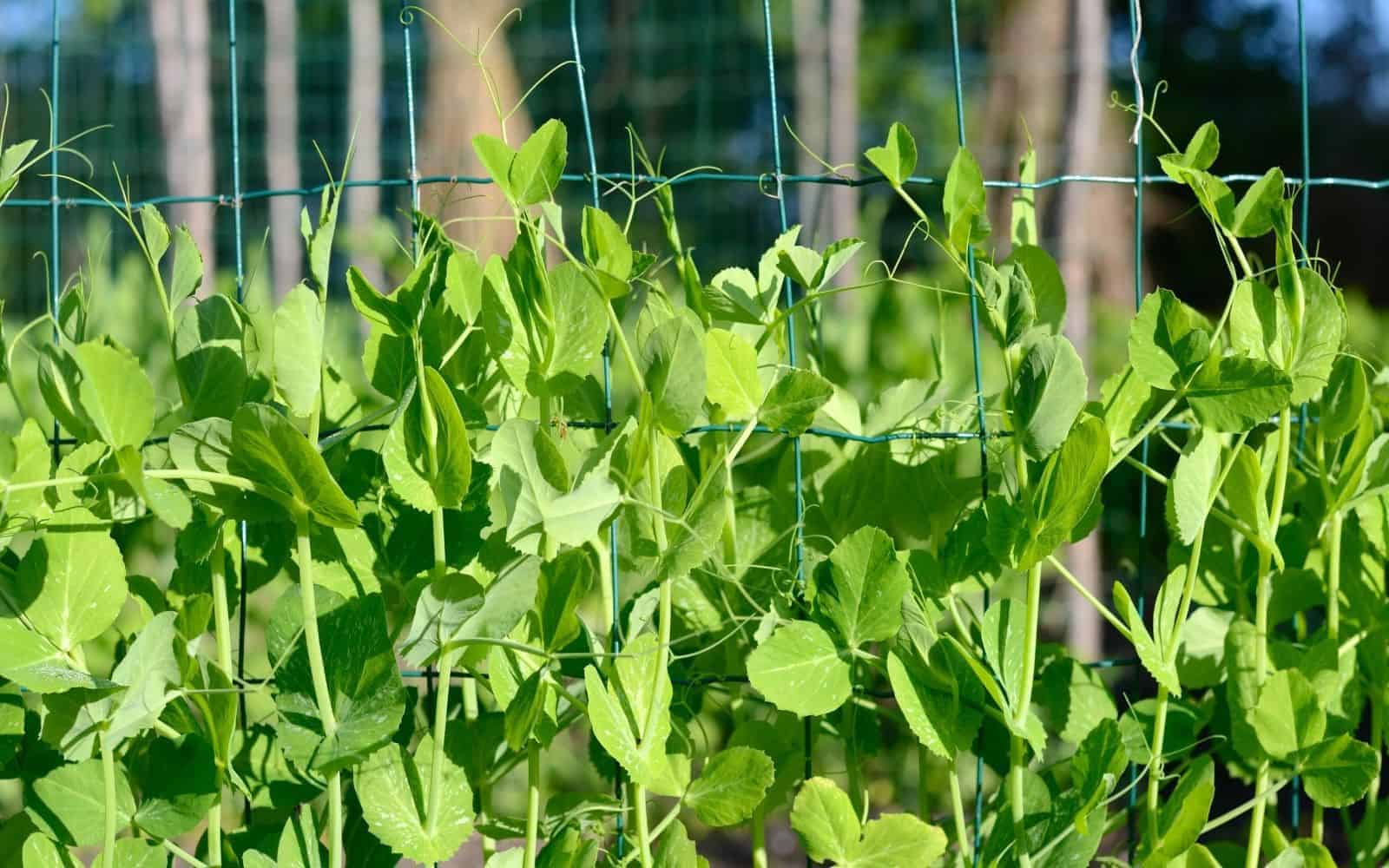
12. Peas
Peas are cold-weather vegetables that are an absolute treat from the fall garden. Peas grow best in cool conditions, and are generally planted in early spring or early fall
Sugar Prince Pea is a great variety for planting in August due to their resistance to powdery mildew. These delicious English peas have a 70-day maturity duration. They can be harvested early as “snow peas” or allowed to fully mature into sweet shelling peas. Sugar Prince Peas planted in mid-August will be ready to harvest in late October.
Peas are generally direct-seeded out into garden soil. Vining peas will need support trellises to climb as they grow. Supports not only keep ripening peas off the ground, but also help increase air circulation around the foliage.
Keep the pea plants well-watered. They grow best with consistently moist soil. Try to water only the soil at the base of the plant rather than watering the leaves, as many types of peas are vulnerable to powdery mildew.
13. Cover Crops
If you’d rather let your garden beds rest for the upcoming cool seasons, consider sowing a cover crop in August. These green manure crops are a great way to enrich the soil and prepare it for next spring. Here are some wonderful cover crops to plant in your veggie beds this August:
- Buckwheat can be grown for about 6 weeks in August/September before being mowed down to make way for fall planting.
- Collard Greens can be planted in August as a cool-season cover crop that breaks up compacted soil.
- Broadleaf Mustard can be planted in August as a cool-season cover crops that adds nutrients to the soil and suppresses pests.


